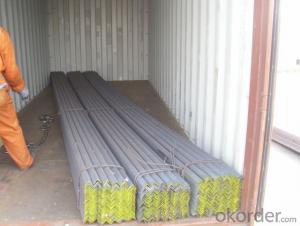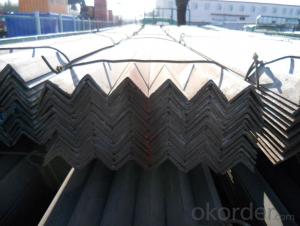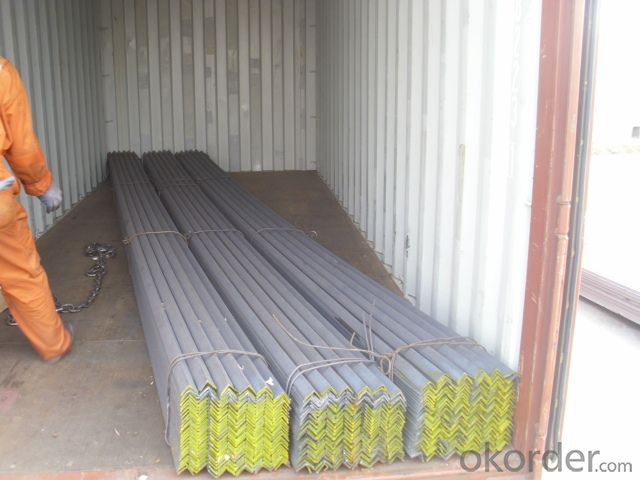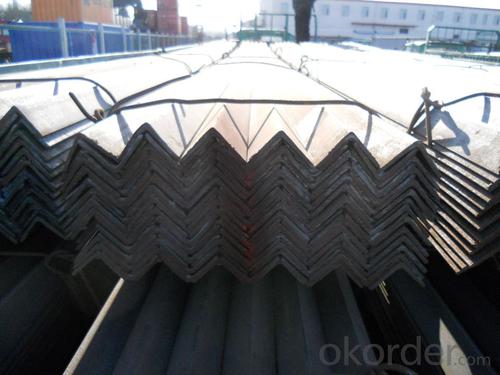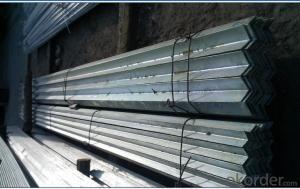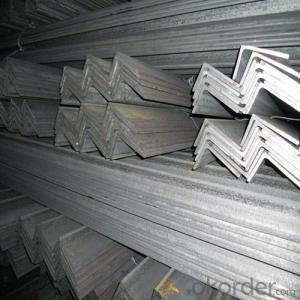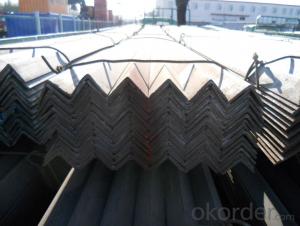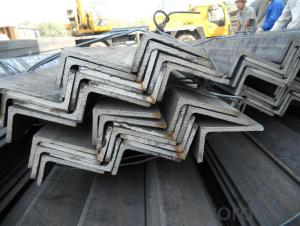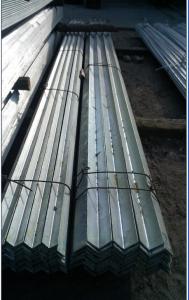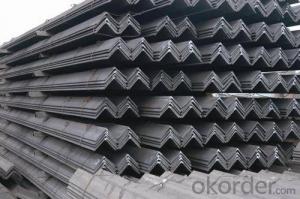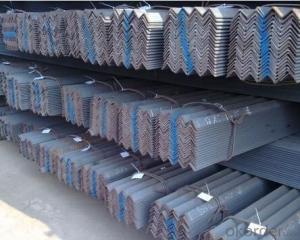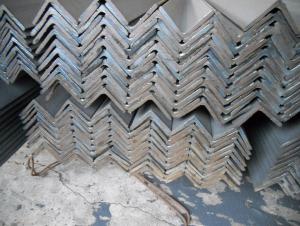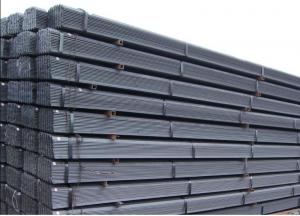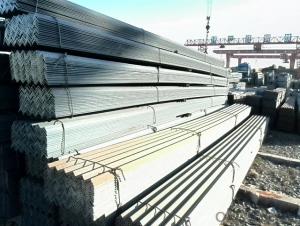Q235 Equal Steel Angle
OKorder Service Pledge
OKorder Financial Service
You Might Also Like
Specifications of Equal Angle Steel
1.Standards:GB
2.Length:6m,9m,12m
3.Material:GBQ235,Q345 or Equivalent
4. Size:
Size (mm) | Mass (mm) | Size (mm) | Mass (mm) |
| 30*30*2.5 | 1.16 | 30*30*3 | 1.373 |
| 30*30*2.7 | 1.246 | 30*30*4 | 1.786 |
Usage & Applications of Equal Anlge Steel
Trusses;
Transmission towers;
Telecommunication towers;
Bracing for general structures;
Stiffeners in structural use.
Packaging & Delivery of Equal Angle Steel
1. Transportation: the goods are delivered by truck from mill to loading port, the maximum quantity can be loaded is around 40MTs by each truck. If the order quantity cannot reach the full truck loaded, the transportation cost per ton will be little higher than full load.
2. With bundles and load in 20 feet/40 feet container, or by bulk cargo, also we could do as customer's request.
3. Marks:
Color mark: There will be color marking on both end of the bundle for the cargo delivered by bulk vessel. That makes it easily to distinguish at the destination port.
Tag mark: There will be tag mark tied up on the bundles. The information usually including supplier logo and name, product name, made in China, shipping marks and other information request by the customer.
If loading by container the marking is not needed, but we will prepare it as customer request.
*If you would like to get our price, please inform us the size, standard/material and quantity. Thank you very much for your attention.
- Q: Can steel angles be used in HVAC systems?
- Yes, steel angles can be used in HVAC systems. They are often used as supports, brackets, or framing components in the installation of air conditioning units, ductwork, and other HVAC equipment. Steel angles provide strength, stability, and durability, making them suitable for various applications within HVAC systems.
- Q: Galvanized steel angles under what conditions?
- Galvanized angle itself coated zinc and iron rust, common need to be coated with a layer of anti rust paint in the construction process, so the galvanized angle in the construction without paint. Suitable for field and outdoor support and Engineering
- Q: What are the different types of steel angles used in storage tank construction?
- Storage tank construction commonly utilizes several different types of steel angles, each serving a crucial role in providing structural support and stability. 1. L-angles, also referred to as unequal angles, find wide usage in storage tank construction. Comprising one longer and one shorter side, these angles form an L-shape. They are frequently employed as tank stiffeners, effectively preventing deformation and maintaining structural integrity. 2. T-angles, alternatively known as tee angles, represent another type of steel angle employed in storage tank construction. With a T-shape, one side is long while the other is shorter and perpendicular. T-angles often function as horizontal and vertical bracing members within tank structures, delivering added strength and stability. 3. Equal angles, also called right angles, consist of two equal sides forming a 90-degree angle. Tank construction commonly utilizes equal angles in various applications, such as providing support for tank roofs, reinforcing corners, or connecting tank components. 4. Bulb angles, or bulb flats, boast a unique shape featuring a flat surface and a bulbous section at one end. These angles are frequently employed in tank support structures, notably the tank bottom, to evenly distribute loads and minimize stress concentrations. 5. Rolled steel sections, such as I-beams, channels, and H-beams, are additionally utilized in storage tank construction alongside the aforementioned angle types. Rolled steel sections offer supplementary strength and support to tank structures, particularly in larger tanks or areas with high load requirements. In summary, the choice of steel angles in storage tank construction hinges upon specific design requirements, load considerations, and structural integrity needs. Selecting the appropriate type and size of angles is crucial to ensure tanks can withstand anticipated loads and environmental conditions.
- Q: What are the common lengths available for steel angles?
- The common lengths available for steel angles vary, but they typically range from 20 feet to 40 feet.
- Q: Can steel angles be welded or joined together?
- Yes, steel angles can be welded or joined together. Welding or joining steel angles typically involves using welding techniques such as arc welding, MIG welding, or TIG welding to fuse the angles together at their connecting edges. This process creates a strong and reliable joint that allows for the structural integrity and stability of the steel angles to be maintained.
- Q: Are steel angles resistant to UV radiation or fading?
- No, steel angles are not resistant to UV radiation or fading.
- Q: What are the different grades of steel angles?
- There are several different grades of steel angles, each with its own unique properties and characteristics. Some of the most commonly used grades include A36, A572, and A588. A36 steel angle is the most commonly used grade and is known for its high strength and versatility. It has a minimum yield strength of 36,000 psi, making it suitable for a wide range of applications. A36 steel angle is often used in construction projects, as well as for structural support in buildings and bridges. A572 steel angle is another popular grade, known for its superior strength and durability. It has a minimum yield strength of 50,000 psi, making it ideal for heavy-duty applications. A572 steel angle is commonly used in construction projects requiring high strength, such as in the construction of skyscrapers and large buildings. A588 steel angle is a corrosion-resistant grade that is often used in outdoor and marine environments. It has a minimum yield strength of 50,000 psi and is designed to withstand exposure to harsh weather conditions and corrosive elements. A588 steel angle is commonly used in coastal areas, as well as in the construction of bridges and other structures exposed to saltwater or high humidity. These are just a few examples of the different grades of steel angles available. The choice of grade depends on the specific application and the required properties, such as strength, corrosion resistance, and durability. It is important to consult with a professional or refer to industry standards when selecting the appropriate grade of steel angle for a particular project.
- Q: Can steel angles be used in curtain wall or facade systems?
- Yes, steel angles can be used in curtain wall or facade systems. Steel angles are commonly used as structural components in these systems to provide support, stability, and attachment points. They can be used to create framework, support cladding materials, and connect various elements of the curtain wall or facade system together. Additionally, steel angles offer excellent strength and durability, making them suitable for withstanding the loads and forces experienced in these applications.
- Q: What is the typical hardness of steel angles?
- The typical hardness of steel angles can vary depending on the specific grade and manufacturing process, but it is generally within the range of 150 to 200 Brinell Hardness Number (BHN).
- Q: Can steel angles be used in architectural applications?
- Yes, steel angles can be used in architectural applications. Steel angles are versatile structural components that can provide stability, support, and aesthetic appeal to various architectural designs. They can be used for framing, bracing, reinforcing, and creating unique shapes and forms in buildings, bridges, and other architectural structures.
Send your message to us
Q235 Equal Steel Angle
OKorder Service Pledge
OKorder Financial Service
Similar products
Hot products
Hot Searches
Related keywords
